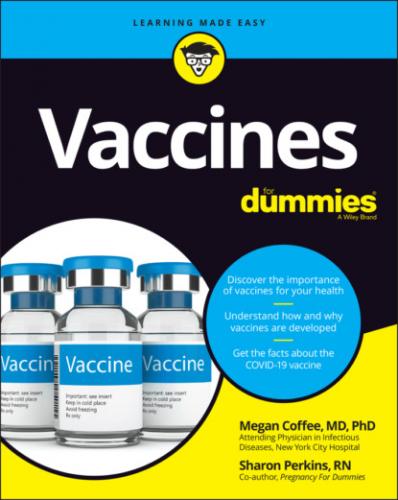www.dummies.com and search for “Vaccines For Dummies Cheat Sheet” in the Search box.
Where to Go from Here
You don’t have to read this book from cover to cover, but if you’re an especially thorough person, feel free to do so! If you just want to find specific information and then get back to work, take a look at the table of contents or the index, and then dive into the chapter or section that interests you.
For example, if you’re just looking for more information on childhood vaccination schedules, go to Chapter 8. Adult schedules are in Chapter 9. If side effects concern you, read Chapter 7. And if your main interest right now is coronaviruses, you’ll find a ton of info in Chapter 3.
Vaccines have changed the world for the better. We hope this book gives you confidence that vaccinating yourself and your family is the best way to keep you all healthy.
Part 1
Getting Started with Vaccine Basics
IN THIS PART …
Focus on the fundamentals of vaccines.
Investigate viruses — what they are and how they work.
Understand coronaviruses from colds to COVID-19.
Get a handle on defeating dangerous bacteria.
Chapter 1
Focusing on Vaccine Fundamentals
IN THIS CHAPTER
Infections that once haunted childhood are now seen only in textbooks. These were the true bogeymen of childhood, the real monsters under the bed. They were common and potentially life-threatening. We now have vaccines for these infections that were so tricky to treat and easy to spread. Most children around the world are vaccinated against these bogeymen, including, among others, measles, polio, diphtheria, tetanus, and smallpox. Vaccines have helped send these diseases packing, even though we still don’t always have good treatments for the diseases themselves.
There’s a lot of information — and misinformation — out there about vaccines. When large groups lose trust in the benefits of vaccination, many people, not just those who don’t want to be vaccinated, can suffer. Diseases like COVID-19 can continue to spread. Those who have weakened immune systems that don’t respond well to vaccines can be infected by others. It’s important that we keep our eyes on the common enemy — infectious diseases.
Realizing the Crucial Role of Vaccines
Vaccinations provide a valuable tool. You can give your immune system a heads-up about infections before you ever see them. You can stop diseases before you ever get sick by giving your immune system a cheat sheet on what to look for. Unlike medications that reduce the symptoms once the illness has begun, vaccines can stop infections before they ever happen. Childhood — and adulthood — have become a lot safer in the process.
Vaccines give your immune system a superpower. Through vaccines, your immune system learns how to stop bad guys it’s never seen before. These bad guys cause infectious diseases. They’re the pathogens, also called germs, which are so tiny that we can see them only with a microscope. These pathogens include bacteria, viruses, fungi, and parasites. Chapter 2 describes different viruses and the vaccines that combat them, while bacteria and their vaccines are discussed in Chapter 4.
Vaccines may not provide 100 percent protection. Some people may not be able to take or benefit from a vaccine; they may be too young or have a weakened immune system. But if enough of us are vaccinated, odds are the pathogen just can’t spread. It can’t jump from person to person. It may infect one person and maybe another, but if most people are vaccinated, it won’t keep finding new people to spread to and will fade away.
This is what herd immunity is all about — when enough people are vaccinated, we can push back the spread of some terrible and deadly diseases. Chapter 11 details the benefits of herd immunity and debunks the myths often perpetuated about vaccines. Diseases can bounce back if fewer people are vaccinated.
We can save many lives if we had more vaccines. Scientific challenges and the lack of funding and motivation have kept some vaccines from being developed. (See Chapter 13 for more information.) New diseases yet to emerge will need vaccines, as we have seen as COVID-19 has spread around the world. (See Chapter 3 for info on COVID-19 and the vaccine.)
It may not seem so exciting now, but we have had reliable and effective vaccines only since the end of the 1700s. At that time, it was found that one mild virus, cowpox, can train our immune system to protect us from a terrible virus, smallpox. (If vaccine history interests you, check out Chapter 12, which discusses the people instrumental in creating a number of vaccines. Chapter 14 describes major pandemics throughout history.)
Many vaccines work on the same principle as this first vaccine did: Show the immune system something harmless but similar to what causes the disease, and the immune system will learn to protect us against the dangerous one too. However, scientists continue working on vaccines to develop new, possibly more effective approaches to train our immune system. Different pathogens require different sorts of vaccines, and for some diseases, vaccines still elude us.
We do have vaccines for a wide range of infections, though. Vaccines can prevent some types of liver disease (hepatitis A and B) and some types
